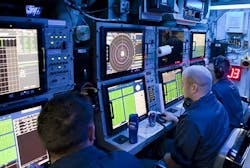What is the U.S. Navy Acoustics-Rapid COTS Insertion (A-RCI) program?
The Navy began the Acoustics-Rapid COTS Insertion (A-RCI) program in the late 1990s as a way to capitalize on commercial off-the-shelf (COTS) rugged server and embedded computing technology to make quick periodic upgrades of submarine sonar signal processing capability.
A-RCI uses a progression of technology insertions (TI) to enhance sonar signal processing without altering existing towed array, hull array, and sphere array sonar equipment aboard fast-attack, ballistic missile, and cruise-missile submarines.
The Lockheed Martin Lockheed Martin Rotary and Mission Systems segment in Manassas, Va. is the A-RCI prime contractor with primary computer equipment supplier Germane Systems in Chantilly, Va. The Naval Sea Systems Command in Washington is in charge of the A-RCI program.
Naval Sea Systems Command periodically re-competes the A-RCI program to determine if contractors other than Lockheed Martin might be best-suited to the program. Lockheed Martin, in turn, periodically re-competes its A-RCI supplier program to determine if Germane Systems is still the right fit.
Related: ARCI continues pushing the bounds of COTS
An open-systems architecture makes the most of commercial processing development, and enables submarine signal processing systems to use complex algorithms that Navy-developed sonar systems such as the AN/BSY-1 and AN/BSY-2 systems could not use.
Since 1997 Lockheed Martin sonar experts have been harvesting the most advanced and most promising COTS digital signal processing (DSP) equipment -- from embedded servers, field-programmable gate arrays (FPGAs), to powerful general-purpose processors -- to achieve the most advanced submarine sonar signal processing at the most reasonable cost.
The A-RCI program is among the most visible U.S. military acknowledgements that COTS technology delivers some of the best capability at the most reasonable cost for defense-related embedded digital signal processing technology.
Using COTS technology enables onboard computing power to grow at nearly the same rate as commercial industry, and facilitates regular updates to submarine sonar-processing software and hardware with minimal disruption to submarine scheduling, Navy officials say.
Related: Submarine designers rely on COTS to broaden undersea warfare missions
The A-RCI program seeks to move the latest COTS DSP technology into submarine signal processing systems aboard Virginia-, Seawolf-, and Los Angeles-class fast attack submarines, as well as aboard Ohio-class missile submarines on a regular basis to keep pace with commercial embedded computing developments.
A-RCI is an open architecture sonar system that Navy officials intend to maintain an advantage in acoustic detection of threat submarines, using legacy sonar sensors. The program regularly refreshes central processors with COTS computer technology and software. A-RCI processors handle data from the submarine’s spherical array, hull array, wide aperture array, high-frequency arrays, and towed arrays.
One of the latest A-RCI technology insertions, TI-16, seeks to provide vast improvements in acoustic sensing aboard U.S. fast-attack, cruise-missile, and ballistic-missile submarines without changing the sonar transducer sensors through the rapid insertion of commercial off-the-shelf (COTS)-based digital signal processing hardware and software.
Learn more: search the Aerospace & Defense Buyer's Guide for companies, new products, press releases, and videos
